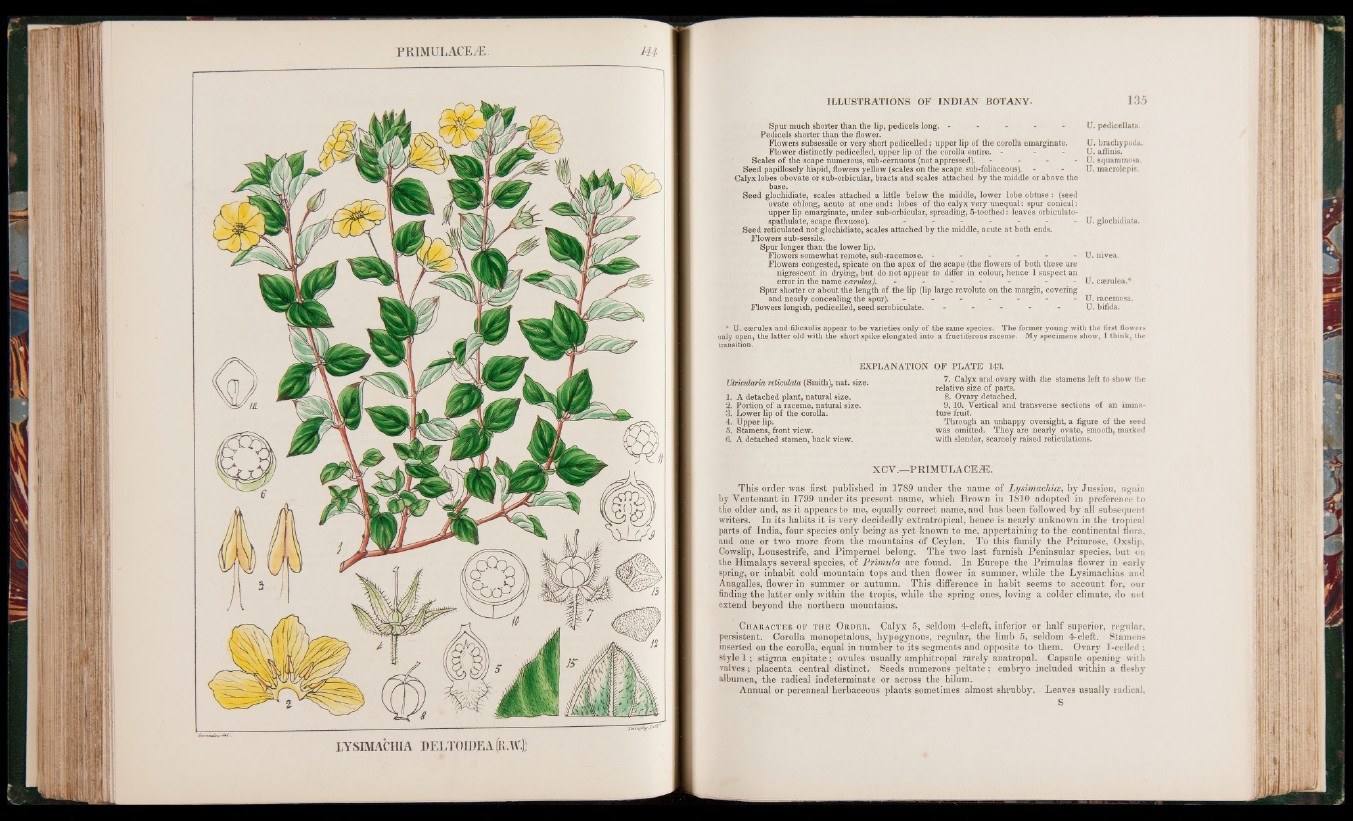
Spur much shorter than the lip, pedicels long. -
Pedicels shorter than the flower.
Flowers subsessile or very short pedicelled; upper lip of the corolla emarginate.
Flower distinctly pedicelled, upper lip of the corolla entire. -
Scales of the scape numerous, sub-cemuous (not appressed). -
Seed papillosely hispid, flowers yellow (scales on the scape sub-foliaceous).
Calyx lobes obovate or sub-orbicular, bracts and scales attached by the middle or above the
base.
Seed glochidiate, scales attached a little below the middle, lower lobe obtuse: (seed
ovate oblong, acute at one end: lobes of the calyx very unequal: spur conical:
upper lip emarginate, under sub-orbicular, spreading, 5-toothed: leaves orbiculato-
spathulate, scape flexuose). -
Seed reticulated not glochidiate, scales attached by the middle, acute at both ends.
Flowers sub-sessile.
Spur longer than the lower lip.
Flowers somewhat remote, sub-racemose. - - - - - -
Flowers congested, spicate on.the apex of the scape (the flowers of both these are
nigrescent in drying, but do not appear to differ in colour, hence I suspect an
error in the name cavrulea). - - - - , - -
Spur shorter or about the length of the lip (lip large revolute on the margin, covering
and nearly concealing the spur). - - - - - - -
Flowers longish, pedicelled, seed scrobiculate. - - - - -
U. pedicellate.
U. brachypoda.
U. affinis.
U. squammosa.
U. macrolepis.
U. glochidiata.
U. nivea.
U. cærulea.*
U. racemosa.
U. bifida.
* U. cterulea and filicaufis appear to be varieties only o f the same species. The former young with the first flowers
only open, the latter old with the short spike elongated into a fructiferous raceme. My specimens show, I think, the
transition.
EXPLANATION
Utricularia reticulata (Smith), nat. size.
1. A detached plant, natural size.
2. Portion of a raceme, natural size.
3. Lower lip of the corolla.
4. Upper lip.
5. Stamens, front view.
6. A detached stamen, back view.
OF PLATE 143.
7. Calyx and ovary with the stamens left to show the
relative size of parts.
8. Ovary detached.
9 ,1 0 . Vertical and transverse sections of an immature
fruit.
Through an unhappy oversight, a figure of the seed
was omitted. They are nearly ovate, smooth, marked
with slender, scarcely raised reticulations.
XCV.—PRIMULACEAL
This order was first published in 1789 under the name of Lysimachice, by Jussieu, again
by Ventenant in 1799 under its present name, which Brown in 1810 adopted in preference to
the older and, as it appears to me, equally correct name, and has been followed by all subsequent
writers. In its habits it is very decidedly extratropical, hence is nearly unknown in the tropical
parts of India, four species only being as yet known to me, appertaining to the continental flora,
and one or two more from the mountains of Ceylon. To this family the Primrose, Oxslip,
Cowslip, Lousestrife, and Pimpernel belong. The two last furnish Peninsular species, but on
the Himalays several species, of Primula are found. In Europe the Primulas flower in early
spring, or inhabit cold »mountain tops and then flower in summer, while the Lysimachias and
Anagalles, flower in summer or autumn. This difference in habit seems to account for, our
finding the latter only within the tropis^ while the spring ones, loving a colder climate, do not
extend beyond the northern mountains.
Character o f the Order. Calyx 5, seldom 4-cleft, inferior or half superior, regular,
persistent. Corolla monopetalous, hypogynous, regular, the limb 5, seldom 4-cleft. Stamens
inserted on the corolla, equal in number to its segments and opposite to them. Ovary 1-celled ;
style 1; stigma capitate; ovules usually amphitropal rarely anatropal. Capsule opening with
valves; placenta central distinct. Seeds numerous peltate; embryo included within a fleshy
albumen, the radical indeterminate or across the hilum.
Annual or perenneal herbaceous plants sometimes almost shrubby. Leaves usually radical,
S